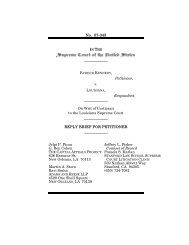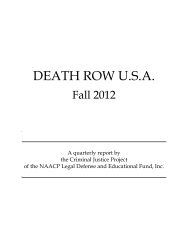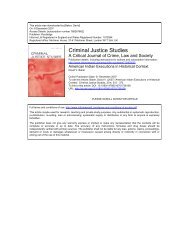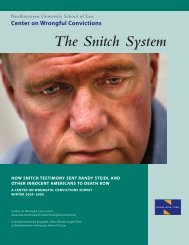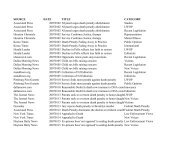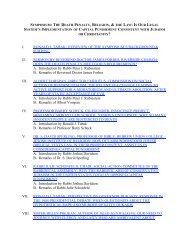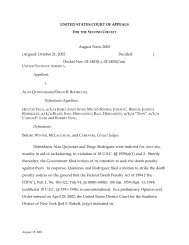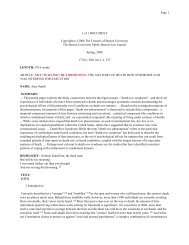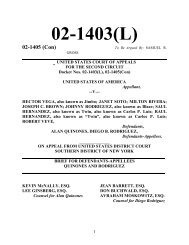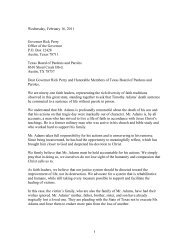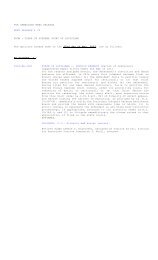Double Tragedies - Families for Human Rights
Double Tragedies - Families for Human Rights
Double Tragedies - Families for Human Rights
- No tags were found...
Create successful ePaper yourself
Turn your PDF publications into a flip-book with our unique Google optimized e-Paper software.
JOE BRUCE’S wife, Amy, was killed in 2006 by their son William, who had been suffering frommental illness <strong>for</strong> several years. William was found not criminally responsible by reason of insanityand was committed to a Maine psychiatric hospital – the very hospital from which he had been releasedjust two months prior to murdering his mother. In a 2008 newspaper article about the case,Joe speaks of obtaining William’s medical records from the hospital eight months after the family’stragedy: “I read through the records and I just remember crying all the way through. My God, thesepeople knew exactly what they were sending home to us.” 1In the immediate aftermath of the tragedy, Joe made a decision to speak publicly about what hadhappened in his family. “I made up my mind that there were no secrets in the Bruce family,” he explains.“I decided that people had to see this, people had to understand. When a reporter from thelocal newspaper called me the day afterward, I told him about how sick Willy was and how we hadtried to get him help and that they had sent him home and that his mother just couldn’t abandon him. I told him that hismother and I <strong>for</strong>give him.”*Elizabeth Bernstein and Nathan Koppel, “A Death in the Family,” The Wall Street Journal, August 16, 2008.and I guess he got fed up and wanted to come home.We weren’t going to say, “Turn him out on thestreet,” so he came home on the bus by himself. Helater told me that as he was walking home from thebus stop, there were these voices talking to him.At home, Jacqueline’s son’s condition deteriorated further.His parents tried to determine what their next stepshould be. At one point he disappeared from his parents’house without telling them where he was going. Only laterdid Jacqueline find out that he was living on the streets onthe opposite end of the country, deteriorating into acutepsychosis and becoming emaciated because he wasn’t gettingenough to eat. “He had developed the delusion that hisfather was somehow taking food away from him and he wasgoing to die of hunger,” Jacqueline explains now. After severalmonths of this, he showed up at his parents’ house unexpectedly,took out a knife, and killed his father with asingle stab. Jacqueline came into the room minutes later,when it was already too late to save her husband.Jacqueline believes that imposing the death penalty onher son would have been “barbaric” and would have onlyadded to the agony that the family was already experiencing.Convicted in a state that only rarely sentenced people todeath, Jacqueline’s son did not face a capital prosecution andwas sentenced to a prison term rather than to death. Wishingthat he had been found Not Guilty by Reason of Insanityso that he could be committed to a psychiatric hospitaland at long last receive treatment, the family struggled withwhat they believed was an inappropriately narrow definitionof insanity, which did not encompass her son’s longstandingdiagnosis of schizophrenia. The family also suffered fromthe additional stigma placed on them because they were relatednot only to the murder victim but also to the person responsible<strong>for</strong> the murder. It was as if “the fact that I was avictim’s family member disappeared,” Jacqueline says now,referring to the fact that she was advised that the district attorneywouldn’t speak with her and that the newspaperheadlines characterized her only as the “murderer’s mother”and not also as the widow of the victim.The distinction between knowing and not knowingright from wrong can blur when an individual behaves inways that suggest recognition of the wrongness of his actions,but at the same time has taken those actions in the contextof delusional thinking. Kim Crespi recalls that herhusband’s call to 911 after he had stabbed the twin girls todeath was viewed as an indication that he knew what he didwas wrong, “but the lawn sprinklers told him to [make thatcall],” she explains now. “He was hallucinating.” (Kim recallsthat David also believed that the children would be ableto be brought back to life.)Carla Jacobs, who was quoted earlier as saying that thethreat of the death penalty did not deter her sister-in-law,Bette, from murdering her own mother, Roma Jacobs, sees itthis way:Let’s face it, most people know that it is wrong tomurder somebody. However, people with mental illnesslike Bette are being driven by their demons.They are victims of an illness that causes them tobelieve that what they are doing is of more moralpurpose than the law itself. Bette planned the murder.She actually, we found out later, tried to hire hitmen to do it <strong>for</strong> her. So there was a lot of planningthat went into the murder. Not effective planning,or she would have gotten away with it, but it wasnot just a case of “Oh, I’m going to murder mymother right now.” It was very definitely a calculatedmurder, but the calculation was based upondelusions and illness.This paradox - that an individual can have the cognitiveability to know that something is wrong but, in the grip ofa delusion or series of delusions, believe that a specific actfalls outside that general rule – can be challenging <strong>for</strong> victims’families to accept. It’s one thing if the delusions and__ 16 __




